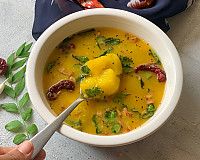Mango is the pulpy and sweet tropical fruit native to India and Southeast Asia. The mango fruit is called as King Of Fruits because of its nutritional benefits and versatile uses. Did you know every part of the mango tree is utilized in some way or the other? Mangoes are generally sweet, although the taste and texture of the flesh vary across different geographical locations, some have a soft, pulpy texture while others are firmer and some may have a fibrous texture. The season of Mango in Indian subcontinent is usually from early April till August and there are a number of varieties. Most popular types of mangoes in India are Alphonsos, Badami, Chausa, Banganapalli, Kesar, Sinduri, Totapuri, Safeda, Kalmi, Neelam, Langda and Dasheri and many many more which are completely region specific.
Apart from the ripe variety of Mangoes, we also have the Raw Mangoes that are used in making many dishes from pickles, to curries, chutneys, juices and sauces. The Raw Mangoes also have a different varieties and each variety differs from region to region.
Natives names: Hindi (Aam), Tamil (Mampala), Kannada (Mavu), Marathi (Aamba)
How to select: If you are buying Ripe Mangoes, then look for plump fruit with a fresh and sweet aroma. The tiny black spots on the mango skin indicate that the overripe. Avoid mangoes that are too soft, shriveled, or bruised. While buying Raw Mangoes, it is always best to buy deep green color, firm and without any black spots.
How to store: It is always best to store ripe mangoes in the refrigerator so that the fruit has a long shelf life. Although if you have bought the Ripe Mangoes that are going to ripe in a few days, it is recommended that they are wrapped in kitchen towels or hay so they ripe evenly. Raw mango can be stored at room temperature for 2 to 3 days.
Culinary Uses: Ripe Mango is a food lovers delight, from beverages, salads, soups and desserts it fits well in any course of the meal. The juice of the fruit is full of bursting flavors and nutritional benefits, it can be consumed on its own or blended with milk and other fruits to prepare smoothies. Raw Mango is used as souring agent in curry recipes and many summer coolers are also made out of it. In Indian subcontinent, raw mango is profoundly used for pickling as well. Dried Mango powder (Amchoor) is also quite commonly used in Indian Cuisine to flavor the food. Variety of jams, jellies, compotes and savory condiments are created using mango all across the globe.
Health Benefits: The Mango fruit is an excellent source of Vitamin-A and flavonoids, one Mango provides the daily requirement of Vitamin A to the human body. These flavonoids like beta-carotene help the vitamin A to impart antioxidant strength and vision-protecting properties, maintaining healthy mucous membranes and skin. Mangoes are also very low in saturated fat, cholesterol, and sodium. Daily consumption of Mangoes helps keeping blood pressure under control, eliminate problems like indigestion and excess acidity.










